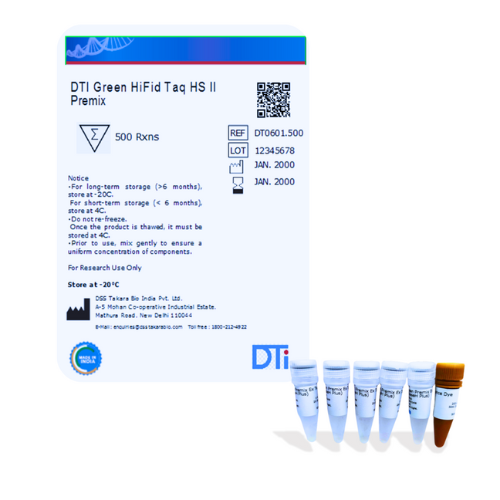DTI Green HiFid Taq HS II Premix
DTI Green HiFid Taq HS II Premix
DTI FabGreen HiFid Taq HS II Premix is a 2X concentration reagent optimized for intercalator-based real-time PCR. It includes green intercalator dye at a concentration appropriate for real time monitoring for easy reaction setup and Tli RNase H to reduce PCR inhibition from residual mRNA in cDNA templates. The modified buffer and hot start PCR enzyme with an anti-Taq antibody ensure high specificity and reliable real-time PCR results.
SKU:DT0601.100

DTI Green HiFid Taq HS II Premix
| Brand | Catalogue Number | Pack Size |
|---|---|---|
| DTI Green HiFid Taq HS II Premix | DT0601.100 | 100 rxn (20 μl volume) |
| DTI Green HiFid Taq HS II Premix | DT0601.500 | 500 rxn (20 μl volume) |
Product Description: DTI Green HiFid Taq HS II Premix is a ready-to-use PCR reagent mix that provides high specificity, sensitivity, and performance for various PCR applications.
Features:
- High specificity minimizes primer-dimer formation and nonspecific amplification.
- Excels with GC-rich targets
- 2X master mix provides convenience.
- High sensitivity: Detects fewer than 100 copies.
- Compatible with all commonly used qPCR instruments.
- Includes DTI Green Master Mix for intercalator-based qPCR.
- Tli RNase H Plus reduces inhibition from mRNA/cDNA hybrids in qPCR.
- Eliminates the need for a separate RNase H digestion step when using low RNase H RT.
DTI Green HiFid Taq HS II Premix - Protocol and Downloads
| Document | Download Link |
|---|---|
| DTI Green HiFid Taq HS II Premix - Protocol | Download User Manual |
| DTI Green HiFid Taq HS II Premix - Certificate of Analysis | Download CoA - DT0601.100 |
| DTI Green HiFid Taq HS II Premix - Certificate of Analysis | Download CoA - DT0601.500 |
| DTI Green HiFid Taq HS II Premix - Promotional Document | Download Flyer |
Results - DTI Green HiFid Taq HS II Premix
Accurate gene expression analysis with DTI Green HiFid Taq HS II Premix
The DTI Green HiFid Taq HS II Premix enzyme efficiently and specifically amplified mouse IL-4 and the GAPDH control. Relative expression of IL-4 was higher in CRA-treated lung samples than in PBS-treated samples.

Figure 1: Gene expression of IL-4 in lung samples.
Relative expression levels of IL-4 as determined by qPCR. Fold expression levels of IL-4 (compared to GAPDH) in mouse lung samples from mice treated with either PBS or CRA.

Figure 2: Relative expression levels of IL-4 in mouse lung samples.
Conclusions:
Upregulation of the cytokine IL-4 is associated with allergies. It was expected that expression of IL-4 would increase during a CRA-induced model of allergic airway inflammation. Indeed, using DTI Green HiFid Taq HS II Premix, a relative increase in IL-4 gene expression was accurately detected in lung samples from mice that were sensitized and challenged with CRA. DTI Green HiFid Taq HS II Premix provided sensitive and accurate detection of gene expression.
Methods:
Total RNA was purified from the lungs of C57BL/6 mice that were sensitized and challenged with either PBS (two mice) or CRA (three mice). RNA was extracted using the RNeasy Mini Kit (Qiagen), and cDNA was synthesized from 1 µl of the extracted RNA using Superscript II RT enzyme (Thermo Fisher Scientific) according to the manufacturers' protocols. Two microliters of the reverse transcription reaction (equivalent to 20 ng total RNA per 20-µl qPCR reaction) were used for qPCR with DTI Green HiFid Taq HS II Premix according to the recommended protocol. qPCR reactions were run in triplicate using probes for mouse IL-4 and GAPDH on an Applied Biosystems 7500 Real-Time PCR System. The relative gene expression level of IL-4 was determined using the delta/delta Ct method.

